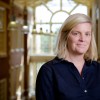This article is more than 5 years old.
Recently, I traveled to Cleveland for the Society of American Archivists (SAA) 2015 Annual Meeting. I found this to be a particularly engaging experience, as I am becoming more and more involved in SAA and the various interest groups. You may see two themes emerge in the blog post: web-archiving and Reference, Access, and Outreach.
My first day in Cleveland, I represented WFU and ZSR at the Archive-It Partner Meeting. You may know that Special Collections & Archives (SC&A) has been using Archive-It as a web archiving platform since 2008. I have been involved with the Wake Forest University Archives Archive-It collection and its managment since 2010 (along with Kevin Gilberston, Craig Fansler, and Stephanie Bennett). Although I wasn’t able to attend the entire meeting, I did mange to sit in on a breakout group about quality assurance that was eye opening and encouraging. Basically, the group exchanged best practices and swapped stories about the difficulty of web archiving. I got some good tips and made contacts that I hope will help our team fine tune our collection.
Day two was filled with the Reference, Access, and Outreach Section’s “Teaching With Primary Resources” unconference. This was a wonderful addition to the regular SAA schedule and it has really made me think about how to “flip” the student experience in Special Collections & Archives. One example is to encourage students to use all their senses (except for taste) to describe materials they are experiencing in Special Collections. This will (hopefully) help people get past the idea that “everything is online” and have them engage with the feel of vellum, the smell of microfilm, and the look of manuscripts. I am hoping to use some of the strategies I learned in the numerous LIB100 classes scheduled in SC&A this Fall.
Day three and I started things off participating on a panel called “Big Web, Small Staff: Web Archiving with Limited Resources.” This was a terrific opportunity to engage with other archivists who are working with web archives on a smaller scale than the usual presenters on this topic. Our panel attempted (and I think succeeded) in breaking down how to implement and manage a web archive with limited resources. What made this different from other panels was that no one presenting was from a large institution with ample staff committed to the project. Everyone on the panel was working with limited staff and funding. The panel simply explained our own best practices and encouraged the majority of the attendees who have not yet, but would like to, set up a web archiving program at their institution.
Some other sessions I attended and found very valuable were “Learning to Manage, Managing to Learn” (one of the panel members was our old friend Audra Eagle Yun!) and “Narrowing the Focus of Social Media” (featuring another former North Carolina colleague, Katie Nash). Although very different panels, I found both applicable to my work.
I have recently been elected to the Reference, Access, and Outreach (RAO) section’s Steering Committee, so spent a bit of time in Cleveland attending the SAA Leadership Orientation and Forum as well as the RAO section meeting. I believe this is a great opportunity to get involved on a national level and have enjoyed working with RAO in the past. They have an active and engaging membership with some fantastic ideas shared at the meeting every year. I am thrilled to be able to work behind the scenes to make this even better.
Every year I find the SAA meeting to be more and more rewarding as I become more active in the profession and this year was no exception. As the current President of the Society of North Carolina Archivists (SNCA) I met up with and talked to many NC colleagues about what they are doing at their institutions. As my involvement grows beyond NC, I look forward to learning more at further SAA conferences. Thank you to the Dean’s office for funding this trip. I am happy to continue the conversation with anyone who would like to hear more about my experience at SAA.

5 Comments on ‘Rebecca @ SAA 2015’
I really like the idea of teaching students to use their senses to appreciate unique materials. It sounds like the Archive-It partners meeting was useful too. And congratulations on your election to the Steering Committee!
Congrats on your election to RAO, they always push me to think like an extrovert in their section meeting activities 🙂 Sounds like it was a good few days gaining some new perspectives.
Sounds like you had a really productive meeting!
Thanks for representing ZSR!
That is a great wrap up. Thanks for sharing.